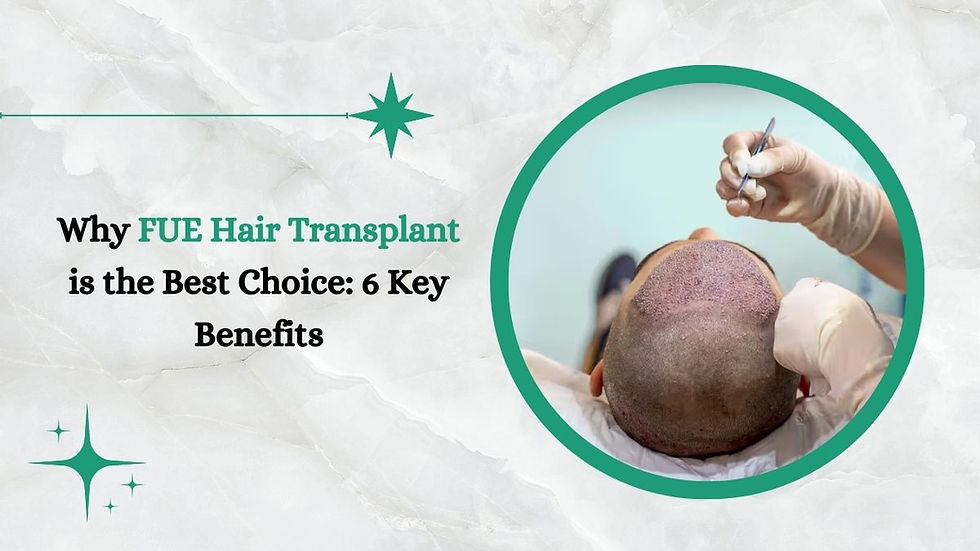Signs You Need Best Hair Transplant Doctor in Jaipur
- anant kumar
- Dec 24, 2024
- 4 min read

Hair is a defining feature of one’s appearance and personality. It not only boosts confidence but also plays a crucial role in how we perceive ourselves. However, hair loss is a common issue faced by many, regardless of age or gender. While some may accept it as a natural phenomenon, others look for ways to regain their luscious locks. If you’re considering the best hair transplant in Jaipur, it’s essential to understand why you might need one, how to spot hair problems requiring a transplant, and the necessary steps involved.
Why a Hair Transplant is Needed
Hair loss can be caused by various factors such as genetics, hormonal imbalances, stress, poor nutrition, or medical conditions. Losing hair is often distressing and can lead to a loss of self-esteem. Here are some common reasons why people opt for a hair transplant:
Genetic Hair Loss (Androgenetic Alopecia): This is the most common type of hair loss and often runs in families. It results in thinning hair or baldness, usually on the crown and hairline in men and general thinning in women.
Traction Alopecia: Caused by hairstyles that pull on the hair roots, such as tight ponytails or braids, leading to gradual hair loss.
Scalp Injuries or Burns: Hair transplant can restore hair in areas where it’s lost due to scars or injuries.
Hair Loss from Medical Treatments: Chemotherapy or certain medications can result in hair thinning or baldness. A hair transplant may help regain hair density post-treatment.
How to Spot Hair Problems Requiring a Transplant
Recognizing hair loss early can make a significant difference in choosing the right treatment. Here are some signs that indicate you might need the best hair transplant doctor in Jaipur:
Excessive Hair Shedding: Losing over 100 strands a day consistently may signal a hair loss issue.
Visible Scalp: If your scalp becomes more noticeable through your hair, it’s a sign of thinning.
Receding Hairline: A noticeable backward movement of your hairline is a key indicator of male pattern baldness.
Bald Patches: The appearance of circular bald patches could mean alopecia areata or other forms of hair loss.
Slow Hair Growth: If your hair grows slower than usual or doesn’t regrow in some areas, it might be time to consult an expert.
Itchy or Irritated Scalp: Persistent scalp issues could lead to hair loss and may require a transplant if untreated.
Steps to Take Before Getting a Hair Transplant
If you’ve identified one or more signs of hair loss, follow these steps to ensure a successful hair transplant procedure:
Research and Choose the Best Hair Transplant in Jaipur: Look for best hair transplant clinic in Jaipur with a proven track record, positive reviews, and experienced professionals. Modern techniques like Follicular Unit Extraction (FUE) and Direct Hair Implantation (DHI) ensure natural results with minimal downtime.
Consultation: Schedule an appointment with a qualified doctor to evaluate your hair loss pattern and understand the root cause. A good consultation will include a scalp analysis and detailed discussion about your medical history.
Understand the Procedure: Familiarize yourself with the hair transplant techniques used, such as:
FUE (Follicular Unit Extraction): Individual hair follicles are extracted and implanted in the thinning or bald areas.
FUT (Follicular Unit Transplantation): A strip of scalp is removed and dissected into grafts for implantation.
Health Check-Up: Ensure you are in good health before the procedure. Discuss any pre-existing conditions or medications with your doctor.
Set Realistic Expectations: Understand that hair growth takes time. The transplanted hair will shed initially, and regrowth typically begins within 3-4 months, with full results visible in 9-12 months.
Prepare for the Procedure: Follow your doctor’s instructions before the surgery. This may include avoiding alcohol, smoking, and certain medications.
Post-Transplant Care
After undergoing the best hair transplant in Jaipur, proper care is crucial for optimal results. Here are some steps to follow:
Protect Your Scalp: Avoid direct sun exposure and wear a loose-fitting hat if necessary.
Gentle Hair Washing: Use mild shampoos as prescribed by your doctor. Avoid vigorous rubbing.
Avoid Strenuous Activities: Skip activities that might cause sweating or strain for at least a week post-procedure.
Follow Up with Your Doctor: Regular check-ups ensure the healing process is on track and any complications are addressed promptly.
Benefits of Choosing the Best Hair Transplant Doctor in Jaipur
Customized Treatment Plans: A skilled doctor will tailor the treatment to suit your hair type and loss pattern.
Natural Results: Advanced techniques ensure a natural hairline and improved density.
Long-Term Investment: A successful hair transplant provides permanent results, making it a worthwhile solution for hair loss.
Boosted Confidence: Regaining your hair can enhance self-esteem and overall quality of life.
Conclusion
Hair loss can be a challenging experience, but it’s not the end of the road. By recognizing the signs early and seeking help from the best hair transplant doctor in Jaipur, you can regain not only your hair but also your confidence. From understanding the need for a transplant to taking the necessary steps before and after the procedure, being informed is the key to achieving the best results. Prioritize your hair health and take the first step toward a better you today! Also Read:- PRP Hair Treatment: What to Expect Before, During, and After the Procedure



Comments